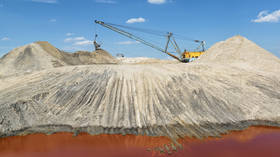‘Dust walls’ could defeat hypersonic weapons – think tank

The US could defend itself against enemy hypersonic gliders by dispersing clouds of dust over large areas through which such projectiles are expected to fly, a new white paper has suggested. Traveling through such an area at high speed would degrade and potentially destroy the weapon.
The idea was discussed in a document published this week by the Center for Strategic & International Studies (CSIS), a Washington-based think-tank. The authors stressed that it “was made possible by support from Raytheon Technologies and Lockheed Martin,” American defense giants developing anti-missile technologies for the US military.
The idea is not unlike what US strategic planners came up with during the peak of the Cold War with the Soviet Union. The proposal at the time was to place nuclear charges around the areas where US intercontinental ballistic missile silos were located. In case of an exchange, the bombs would blow up minutes before the Soviet nukes would hit. With hundreds of thousands of tons of radioactive dust in the air, enemy reentry vehicles arriving at high speed would get damaged by the particles, saving the American missiles for a retaliatory strike.
Reentry vehicle nosetip after flying through rain at Mach 10, Sandia photo. One of the many engineering challenges to consider when designing hypersonic weapons. pic.twitter.com/yjh2zSYGLv
— Masao Dahlgren (@masao_dahlgren) February 1, 2022
The modern-day incarnation would use the same concept of subjecting a rapid-flying weapon to a cloud of dust it was not designed to withstand.
“Absent heavy mitigation measures, disruption of the hypersonic flowfield could lead to progressive deterioration of performance or a mission kill, if not outright catastrophic failure,” the report predicted.
The particles would be engineered to remain suspended in the thin upper layer of atmosphere, through which hypersonic gliders travel, for tens of minutes, requiring less accuracy in the timing of the countermeasure. The artificial dust could be metallic, pyrotechnic, or made of other material, and deployed by a missile or an airborne platform.
“Given the higher speeds earlier in the flight of a hypersonic glider, a ‘wall of dust’ would be more effective earlier rather than later in its flight,” the report suggested.
The white paper explored other ideas of how to tackle hypersonic weapons, not only gliders but also cruise missiles. They ranged from deploying anti-missile assets in a way that would force adversaries to plot less favorable attack paths, to using powerful microwaves to fry the missile’s electronic components, to trying to destroy them with laser weapons.
Hypersonic weapons are considered a game changer in the strategic balance of power, because the speed at which they travel and their ability to maneuver unpredictably mid-flight makes them much more difficult to intercept by traditional means than older ICBMs, which fly in predictable trajectories.
Russia fields what it claims to be a functional hypersonic glider called Avangard as part of its nuclear deterrence force. China is also understood to have highly advanced prototypes of this kind of weaponry.
The US has been investing heavily in its national anti-ballistic missile system since 2002, when it withdrew from a treaty that it had signed with the USSR that prevented both nations from developing relevant technologies.
Moscow has said it had to develop hypersonic capability to rebalance the degradation of its nuclear deterrence due to growing US anti-missile capabilities.













